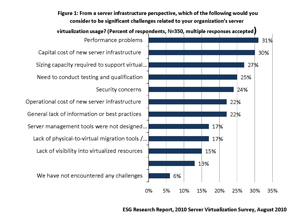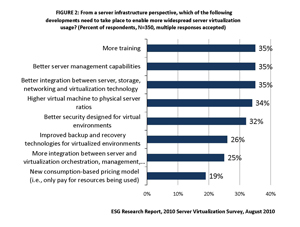Vendor View
The Benefits of Server and Storage Integration
Vendor View: IT seeking to accommodate the proliferation of virtualization projects
- By Heidi Biggar
- 10/05/2010
As virtualization becomes more pervasive across the data center, and more tier-one and tier-two applications are migrated off physical hosts and onto virtual server platforms, the tight integration between virtualized servers and storage becomes increasingly important, if not essential. In fact, some organizations have already reached the tipping point in their efforts to achieve maximum virtualization in their environments, and many more will soon follow.
For these organizations, performance and capacity issues have already stressed their virtualized IT infrastructures to a critical point. This has caused some to delay or even cancel additional virtualization projects in an effort to prevent key virtualization barometers--such as application performance, virtual machine density, storage utilization and backup and recovery rate--from falling below certain thresholds.
Enterprise Strategy Group's 2010 Server Virtualization Survey highlights this trend. When survey respondents were asked to identify what they considered to be the most significant challenges related to their virtualization use, performance, server capital costs and capacity sizing issues ranked one, two and three, respectively (see Fig. 1). Further, when respondents were asked what was needed to enable more widespread use of server virtualization, 35 percent said better integration between server, storage, networking and virtualization technology (see Fig. 2).
Virtual server and storage vendors recognize this trend and are working together to develop storage APIs so organizations can continue to experience the full benefits of virtualization as environments scale. These APIs integrate the storage and virtual server worlds, enabling virtual servers and storage to communicate more effectively and ultimately perform the tasks each does best. And, ultimately, they will enable the huge leaps in performance and scale that will continue to propel server virtualization along its evolutionary path by creating a technology infrastructure that maximizes the actual capabilities of the storage and virtual server platforms.

[Click image to view larger version.]
|
Figure 1. From a server infrastructure perspective, which of the following would you consider to be significant challenges related to your organization's server virtualization usage? (Percentage of respondents, N=350, multiple responses accepted.) |

[Click image to view larger version.]
|
Figure 2. From a server infrastructure perspective, which of the following developments need to take place to enable more widespread server virtualization usage? (Percentage of respondents, N=350, multiple responses accepted.) |
Benefits of Integration from a Virtual Server Perspective
Virtualized environments are constantly changing and evolving. Deployments are getting bigger, more expansive, and including more tier-one applications. This is helping to transform the data center as we know it, but it is also introducing new challenges.
Specifically, organizations are reporting I/O issues as well as a variety of problems resulting from virtual server sprawl, including management as well as server and storage utilization issues. This is where server and storage integration comes in.
At a very high level, this integration -- which is done through storage APIs -- can enable more efficient, agile and cost-effective virtualized server environments. As an example, storage APIs can help offload resource-intensive storage processing from virtual server host environments to participating storage systems, and in doing so, free up critical I/O bandwidth to support additional virtual machines and workloads, or improve existing application metrics.
Additionally, these APIs can help organizations leverage other storage-based capabilities, such as copy and provisioning features, to further optimize the virtual server environment. Here again, the purpose of the API is to let the storage environment handle the tasks it does best, and let the virtual server environment do what it does best.
In the case of the copy function, for example, the storage system assumes full control, or responsibility for making full copies of the data with no virtual server involvement. As for provisioning, the storage system assumes responsibility for the process (leveraging API-enabled storage performance enhancements) to both speed up the provisioning of new virtual machines as well as improve overall virtual machine density. These are two key considerations, especially for large-scale virtual server and VDI deployments.
Benefits of Integration from a Storage Perspective
Server and storage integration also gives organizations important access to the feature sets of the storage systems themselves, which can be leveraged to further enhance the virtualized server environment. Since supported feature sets vary from vendor to vendor, it is important for organizations to carefully review options to determine the one that will provide the most value for their environments.
A sample check list would include technologies such as thin provisioning, controller design, storage tiering, replication, and storage virtualization -- all of which can further improve performance, scalability, management and overall data protection.
For example, the type of storage controller (e.g., active/active symmetric load balancing versus active/passive) can affect overall virtual server performance. Similarly, thin provisioning, storage virtualization and storage tiering can further improve storage utilization in virtual server environments as well as reduce storage-related costs significantly.
Benefits of Integration from a Data Protection Perspective
On the data protection front, organizations are looking to improve management and backup and recovery speeds as well as expand business continuity and disaster recovery processes to additional applications and workloads. Again, the tight integration between servers and storage, made possible by storage APIs, is key to this success.
In the case of backup and recovery, APIs enable organizations to perform centralized, LAN-free backup and recovery without agents and, more importantly, without tasking the virtual server environment with backup processing I/O. Additionally, these APIs enable incremental--as opposed to full--backup as well as incremental and full recovery of virtual machines. The net effect for organizations is a much more streamlined and efficient backup and recovery process for their virtual environments, one that is easier to manage, significantly less resource-intensive and overall more cost-effective.
Similar progress is also being made on the business continuity and disaster recovery fronts through a variety of APIs and assorted plug-ins, which enable virtual server environments to leverage system-based replication capabilities to better and more efficiently protect against downtime and outages both locally and across geographically disparate sites.
Benefits of Integration to Organizations
While organizations of all sizes can benefit from integrating servers and storage, enterprise environments are likely to experience the growing pains of rapidly expanding virtualized environments first, and most acutely.
Tight integration provides significant improvements to IT environments through improved virtual server performance, greater virtual machine density, simplified management and better data protection. Conversely, without it, the potential of server virtualization is limited.
Organizations that connect the dots between performance and capacity issues and server and storage integration, breaking down the historically siloed walls between servers, storage and networking, will find themselves at a competitive advantage.
About the Author
Heidi Biggar is Solutions Marketing Principal at Hitachi Data Systems.